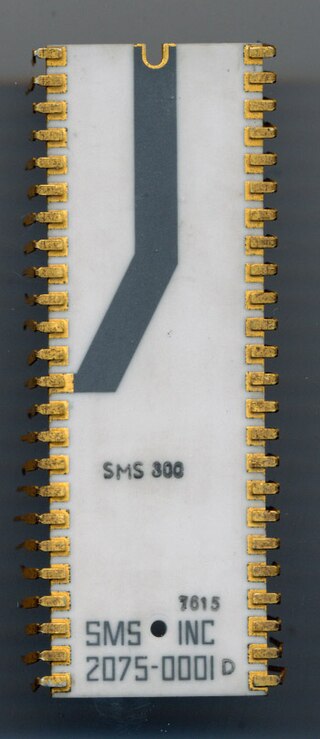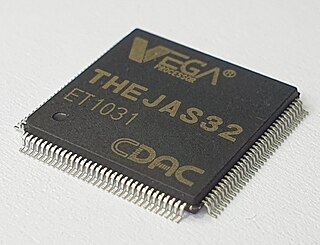Related Research Articles

A microprocessor is a computer processor where the data processing logic and control is included on a single integrated circuit (IC), or a small number of ICs. The microprocessor contains the arithmetic, logic, and control circuitry required to perform the functions of a computer's central processing unit (CPU). The IC is capable of interpreting and executing program instructions and performing arithmetic operations. The microprocessor is a multipurpose, clock-driven, register-based, digital integrated circuit that accepts binary data as input, processes it according to instructions stored in its memory, and provides results as output. Microprocessors contain both combinational logic and sequential digital logic, and operate on numbers and symbols represented in the binary number system.

The StrongARM is a family of computer microprocessors developed by Digital Equipment Corporation and manufactured in the late 1990s which implemented the ARM v4 instruction set architecture. It was later acquired by Intel in 1997 from DEC's own Digital Semiconductor division as part of a settlement of a lawsuit between the two companies over plagiarism. Intel then continued to manufacture it before replacing it with the StrongARM-derived ARM-based follow-up architecture called XScale in the early 2000s.

The Intel 8085 ("eighty-eighty-five") is an 8-bit microprocessor produced by Intel and introduced in March 1976. It is software-binary compatible with the more-famous Intel 8080 with only two minor instructions added to support its added interrupt and serial input/output features. However, it requires less support circuitry, allowing simpler and less expensive microcomputer systems to be built. The "5" in the part number highlighted the fact that the 8085 uses a single +5-volt (V) power supply by using depletion-mode transistors, rather than requiring the +5 V, −5 V and +12 V supplies needed by the 8080. This capability matched that of the competing Z80, a popular 8080-derived CPU introduced the year before. These processors could be used in computers running the CP/M operating system.

AVR is a family of microcontrollers developed since 1996 by Atmel, acquired by Microchip Technology in 2016. These are modified Harvard architecture 8-bit RISC single-chip microcontrollers. AVR was one of the first microcontroller families to use on-chip flash memory for program storage, as opposed to one-time programmable ROM, EPROM, or EEPROM used by other microcontrollers at the time.

The Am5x86 processor is an x86-compatible CPU announced in November of 1995 by AMD for use in 486-class computer systems. It began shipping in December of 1995, with a base price of $93 per unit in bulk quantities. Before being released, it was in development under the codename "X5".

The DECstation was a brand of computers used by DEC, and refers to three distinct lines of computer systems—the first released in 1978 as a word processing system, and the latter two both released in 1989. These comprised a range of computer workstations based on the MIPS architecture and a range of PC compatibles. The MIPS-based workstations ran ULTRIX, a DEC-proprietary version of UNIX, and early releases of OSF/1.
LEON is a radiation-tolerant 32-bit central processing unit (CPU) microprocessor core that implements the SPARC V8 instruction set architecture (ISA) developed by Sun Microsystems. It was originally designed by the European Space Research and Technology Centre (ESTEC), part of the European Space Agency (ESA), without any involvement by Sun. Later versions have been designed by Gaisler Research, under a variety of owners. It is described in synthesizable VHSIC Hardware Description Language (VHDL). LEON has a dual license model: An GNU Lesser General Public License (LGPL) and GNU General Public License (GPL) free and open-source software (FOSS) license that can be used without licensing fee, or a proprietary license that can be purchased for integration in a proprietary product. The core is configurable through VHDL generics, and is used in system on a chip (SOC) designs both in research and commercial settings.

The AMD Am29000, commonly shortened to 29k, is a family of 32-bit RISC microprocessors and microcontrollers developed and fabricated by Advanced Micro Devices (AMD). Based on the seminal Berkeley RISC, the 29k added a number of significant improvements. They were, for a time, the most popular RISC chips on the market, widely used in laser printers from a variety of manufacturers.
Nios II is a 32-bit embedded processor architecture designed specifically for the Altera family of field-programmable gate array (FPGA) integrated circuits. Nios II incorporates many enhancements over the original Nios architecture, making it more suitable for a wider range of embedded computing applications, from digital signal processing (DSP) to system-control.
Alchemy is a family of ultra low power embedded microprocessors originally designed by Alchemy Semiconductor for communication and media devices. Alchemy processors are SoCs integrating a CPU core, a memory controller, and a varying set of peripherals. All members of the family use the Au1 CPU core implementing the MIPS32 instruction set by MIPS Technologies.

Am2900 is a family of integrated circuits (ICs) created in 1975 by Advanced Micro Devices (AMD). They were constructed with bipolar devices, in a bit-slice topology, and were designed to be used as modular components each representing a different aspect of a computer control unit (CCU). By using the bit slicing technique, the Am2900 family was able to implement a CCU with data, addresses, and instructions to be any multiple of 4 bits by multiplying the number of ICs. One major problem with this modular technique was that it required a larger number of ICs to implement what could be done on a single CPU IC. The Am2901 chip was the arithmetic logic unit (ALU), and the "core" of the series. It could count using 4 bits and implement binary operations as well as various bit-shifting operations.

The Intel 8255 Programmable Peripheral Interface (PPI) chip was developed and manufactured by Intel in the first half of the 1970s for the Intel 8080 microprocessor. The 8255 provides 24 parallel input/output lines with a variety of programmable operating modes.

Intel 8237 is a direct memory access (DMA) controller, a part of the MCS 85 microprocessor family. It enables data transfer between memory and the I/O with reduced load on the system's main processor by providing the memory with control signals and memory address information during the DMA transfer.
Communications Processor Module (CPM) is a component of Motorola 68000 family (QUICC) or Motorola/Freescale Semiconductor PowerPC/Power ISA (PowerQUICC) microprocessors designed to provide features related to imaging and communications. A microprocessor can delegate most of the input/output processing to the Communications Processor Module and the microprocessor does not have to perform those functions itself. Some input/output functions require quick response from the processor, for example due to precise timing requirements during data transmission. With CPM performing those operations, the main microprocessor is free to perform other tasks.

The 8X300 is a microprocessor produced and marketed by Signetics starting 1976 as a second source for the SMS 300 by Scientific Micro Systems, Inc. Although SMS developed the SMS 300, Signetics was the sole manufacturer of this product line. In 1978 Signetics purchased the rights to the SMS 300 series and renamed it 8X300.
К1839 is a microprocessor chipset developed between 1984 and 1989 at the Angstrem Research Institute by the same team that developed the 1801BMx series of CPUs. It was the first Soviet, and later the first Russian 32-bit microprocessor system. From a programmer's point of view, it was a complete replica of the VAX 11/750 Comet and included floating-point arithmetic, unlike the MicroVAX microprocessors produced by DEC. The chipset included a processor, a coprocessor for integer and floating-point arithmetic, a memory controller and a bus adapter. It was fabricated in a 3 µm process. The Electronika-32 computer and a VAX-PC board were built based on this chipset, as well as the aerospace on-board digital computer SB3541. The 1839 chipset is still in production, and is used in the control systems of the GLONASS-M satellites.

VEGA Microprocessors are a portfolio of indigenous processors developed by C-DAC. The portfolio includes several 32-bit/64-bit Single/Multi-core Superscalar In-order/Out-of-Order high performance processors based on the RISC-V ISA. Also features India’s first indigenous 64-bit, superscalar, Out-of-order processor which is the main highlight of this portfolio. The Centre for Development of Advanced Computing (C-DAC) is an autonomous Scientific Society, operating under the Ministry of Electronics and Information Technology (MeitY), Govt. of India. The Microprocessor Development Programme (MDP) was initiated and funded by MeitY with the mission objective to design and develop indigenously, a family of Microprocessors, related IPs and the complete ecosystem to enable fully indigenous product development that meets various requirements in the strategic, industrial and commercial sectors. As part of the project C-DAC has successfully developed the VEGA series of microprocessors in soft IP form, which include32-bit Single-core (In-order), 64-bit Single-core, 64-bit Dual-core (Out-of-order), and 64-bit Quad-core (Out-of-order). These high-performance processors are based on the open-source RISC-V Instruction Set Architecture. The tape out of some of these processor chips have also been planned.
References
- The Am2900 Family Data Book, by AMD
- 32-bit Microprogrammable Products Am29c300/29300, by AMD
- Am29PL100 Field Programmable Controllers, by AMD
- http://www.cpushack.net/Am29k.html
- https://web.archive.org/web/20060302090939/http://mevaldez.home.mchsi.com/BitSlice.pdf
- AMD Bipolar Microprocessor Logic and interface Am2900 Family 1983 Data Book